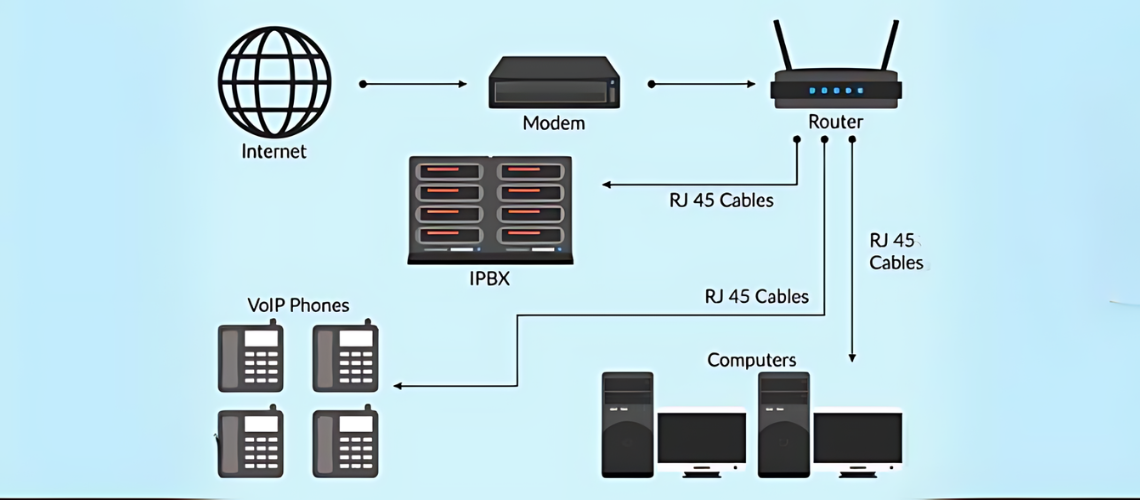As technology progresses, companies seek ways to make their communication smoother. One solution making waves is Voice over Internet Protocol (VoIP) cabling. Incorporating VoIP into your business setup can help you enjoy various benefits that improve connectivity, productivity, and efficiency.
VoIP cabling is a game-changer in telecommunications, offering businesses a cheaper alternative to traditional phone systems. With VoIP, your voice travels over the internet instead of old-fashioned telephone lines. This cuts down communication costs and unlocks a whole new set of features and abilities.
What is VoIP Cabling and How Does It Work?
VoIP cabling uses internet connections to send voice data between callers. Unlike old-school phone systems that need dedicated copper wiring, VoIP taps into existing internet infrastructure to get the message across. Here’s the lowdown on how it operates:
- Analog to Digital Conversion: When you call VoIP, your voice changes from analog signals to digital data packets. These packets contain encoded audio info that can be shot over the internet.
- Packet Switching: Once your voice is digitized, it travels the internet using packet-switching tech. This means breaking your audio into smaller packets, sending them individually, and then reassembling them at the other end.
- Routing and Delivery: Your voice packets journey through various internet nodes, taking the quickest route to their destination. They’re pieced back together when they arrive so the receiver hears what you said.
- Integration with Existing Setups: VoIP cabling smoothly fits into your current network setup, eliminating the need for separate phone lines. This makes maintenance easier and lets you manage communication resources more flexibly.
- Extra Features: VoIP doesn’t just handle basic calls; it comes with many fancy extras like voicemail, call forwarding and conferencing. These features let businesses tailor their communication setup to suit their exact needs.
With VoIP cabling, companies can change how they communicate, encouraging collaboration, efficiency, and growth. As tech keeps advancing, embracing innovative solutions like VoIP is key to staying ahead in today’s competitive market.
Benefits of VoIP Cabling Services
Integrating Voice over Internet Protocol (VoIP) cabling into your business infrastructure offers many advantages that significantly enhance communication efficiency and cost-effectiveness. Let’s explore the key benefits in detail:
Easy Installation:
VoIP cabling stands out for its straightforward installation process. Unlike traditional phone systems that often require extensive wiring and setup, VoIP can be implemented with minimal hassle. With the right equipment and expertise, VoIP cabling can be up and running in a relatively short timeframe, minimizing disruption to your operations and ensuring a smooth transition to the new system.
Advanced Features:
One of the most compelling aspects of VoIP cabling is its rich array of advanced features. From voicemail transcription and call forwarding to auto-attendants and video conferencing, VoIP offers a comprehensive suite of communication tools that go beyond basic voice calling. These features enhance productivity and facilitate seamless collaboration and communication within your organization.
Remote Work Connectivity:
In today’s increasingly remote-oriented work environment, staying connected from anywhere is crucial. VoIP cabling enables seamless communication regardless of location, allowing remote workers to access the same robust features and functionality as their in-office counterparts. This flexibility fosters productivity and supports a more inclusive and adaptable work culture where employees can collaborate effectively regardless of physical location.
Future-Proof Infrastructure:
Investing in VoIP cabling represents a strategic move towards future-proofing your business communication infrastructure. VoIP is inherently scalable and adaptable, unlike traditional phone systems that may require costly upgrades or replacements as technology evolves. As new features and functionalities emerge, VoIP systems can easily accommodate changes without requiring extensive hardware overhauls, ensuring that your communication infrastructure remains relevant and efficient in the long term.
Reduced Operating Costs:
One of the most significant advantages of VoIP cabling is its potential for cost savings. By leveraging the existing internet infrastructure for voice communication, businesses can significantly reduce their operating expenses associated with traditional phone lines. With VoIP, long-distance calls are often included at no extra cost, and maintenance expenses are typically lower, resulting in substantial savings over time. Additionally, VoIP systems are highly efficient, allowing businesses to optimize their communication resources and minimize wastage, further driving down costs.
In summary, VoIP cabling offers many benefits that can transform your business communication strategy. From easy installation and advanced features to remote work connectivity and cost savings, VoIP provides a versatile and efficient solution for modern organizations. By embracing VoIP, businesses can streamline communication processes, enhance collaboration, and position themselves for success in an increasingly digital and interconnected world.
5 Ways You Can Leverage VoIP Cabling for Sound Quality
Ensuring crystal-clear sound quality in your business communication is essential for maintaining professionalism and fostering effective collaboration. Here are five strategies for leveraging Voice over Internet Protocol (VoIP) cabling to enhance sound quality:
Communication Across Multiple Locations:
VoIP cabling enables seamless communication across multiple locations, regardless of geographical barriers. Businesses can ensure consistent sound quality across all branches and remote offices by leveraging a unified communication system. Whether it’s a conference call between teams in different cities or a client meeting with international participants, VoIP ensures that every voice is heard loud and clear, fostering efficient communication and collaboration.
Integration With Applications:
Integrating VoIP cabling with other business applications can significantly enhance sound quality and overall communication efficiency. Businesses can streamline communication processes and ensure optimal sound quality during calls and conferences by seamlessly integrating VoIP with applications such as CRM systems, email clients, and collaboration platforms. This integration allows access to relevant information during calls, enabling more productive discussions and decision-making.
Mobility for Remote Workforce:
With the rise of remote work, ensuring high-quality communication for remote employees is more important than ever. VoIP cabling offers mobility solutions that empower remote workers to stay connected from anywhere, ensuring consistent sound quality regardless of location. Whether working from home, a coffee shop, or a coworking space, remote employees can rely on VoIP to deliver clear and reliable communication, enabling seamless collaboration with colleagues and clients.
Centralized Management:
Centralized management capabilities provided by VoIP cabling systems play a crucial role in maintaining sound quality across the organization. With centralized management tools, IT administrators can monitor and manage voice traffic in real-time, ensuring optimal performance and sound quality. By proactively identifying and addressing potential issues, such as network congestion or bandwidth limitations, IT teams can optimize the VoIP system to deliver consistent and high-quality audio experiences for all users.
Data-Driven Insights:
VoIP cabling systems offer valuable data-driven insights to help businesses optimize sound quality and overall communication performance. With analytics tools built into VoIP platforms, businesses can gain valuable insights into call quality metrics, such as jitter, latency, and packet loss. Armed with this data, IT teams can identify areas for improvement and implement targeted solutions to enhance sound quality and ensure a superior communication experience for users.
In summary, VoIP cabling offers a range of powerful tools and capabilities for optimizing sound quality and enhancing communication efficiency. By leveraging VoIP for communication across multiple locations, integrating it with business applications, providing mobility for remote workers, implementing centralized management, and leveraging data-driven insights, businesses can ensure crystal-clear sound quality and foster effective collaboration across the organization.
Conclusion
Using Voice over Internet Protocol (VoIP) cabling gives businesses a robust solution to enhance communication efficiency and sound quality. VoIP technology facilitates seamless communication across multiple locations, integrates with applications for improved productivity, offers mobility for remote workers, enables centralized management, and provides valuable data-driven insights for continuous improvement.
Consider Shock I.T. Support‘s comprehensive services as you begin your VoIP transition. Shock I.T. Support specializes in providing advanced VoIP solutions tailored to your business needs. With their expertise and commitment to excellence, Shockit ensures seamless implementation and ongoing support, empowering you to maximize the benefits of VoIP cabling. Take the next step towards transforming your communication infrastructure with Shockit’s services today.
FAQs
Q. 1 How does VoIP differ from traditional phone systems?
VoIP transmits voice data online, while traditional phone systems use dedicated copper wiring. VoIP offers advanced features, cost savings, and scalability.
Q. 2 Is specialized cabling required for VoIP installations?
While specialized cabling isn’t mandatory, ensuring quality internet connectivity is crucial for optimal VoIP performance.
Q. 3 Can I use my existing cabling for VoIP implementation?
In many cases, existing cabling can be used for VoIP, but assessing its quality and compatibility with VoIP requirements is essential.
Q. 4 How does VoIP cabling contribute to improved call quality?
VoIP cabling optimizes data transmission, reducing latency and packet loss, leading to clearer and more reliable calls.
Q. 5 Can VoIP cabling support remote and mobile users?
Yes, VoIP cabling enables seamless communication for remote and mobile users, providing flexibility and accessibility across various devices and locations.





